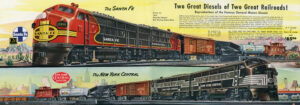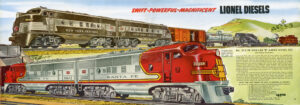Lionel F3 sets that never existed are a constant source of conversation among collectors. One area of focus is the late 1940s. Amid the ordinary items produced in vast quantities, there were some advertised that were probably never produced – but maybe they were.
Lionel’s first O gauge F3 diesels came in freight sets with unique boxcars. The New York Central and Santa Fe sets shown in the catalogs for 1948 and 1949 interested consumers then – and collectors now – because of their rolling stock.
Those top-of-the-line diesel freight sets are showcased in Lionel Trains of the 1940s, the 100-page special publication from Classic Toy Trains.
Lionel F3 sets that never were

When researching the outfits, engines, rolling stock, accessories, and other items released during that fascinating decade, I dug into the catalogs. The illustrations in them were revealing.
There was artwork showing locomotives and freight cars unlike those Lionel actually made. Two examples were the No. 2560 crane car in brown in the 1946 catalog and the No. 2856 hopper shown as a silver car with Baltimore & Ohio markings. It’s thought neither model was ever produced, but collectors have long been searching for them.
Equally tantalizing are the double-door automobile cars pictured in 1948 as components of the No. 2133W outfit. The catalog described that set as a four-car freight train with either the New York Central or the Santa Fe twin diesel locomotive with horn (No. 2333 A-A combination).
Both versions of the outfit were illustrated, one with Santa Fe units and the other with New York Central models. Three of the cars were identical: Nos. 2555 Sunoco single-dome tank car, 3459 operating ore dump car with coal, and 2357 Southern Pacific-type caboose with illumination.
Differing was the fourth car, a No. 2458 automobile boxcar. Instead of the model with Pennsylvania RR markings (first cataloged in 1946), two new ones were shown. The Santa Fe set featured a brown car with that railroad’s lettering and herald. The New York Central set came with a brown car decorated, not for that railroad, but for Southern Pacific.
No evidence exists that either automobile boxcar was ever produced; we can only assume that any such outfits came with the Pennsy car.
Sets for 1949
For the final year of the decade, Lionel’s team of engineers brought out O gauge freight cars with markings connecting them to the two pairs of F3 diesels.

Both the New York Central and the Santa Fe versions of set No. 2151W, a five-car freight train, included updated versions of the Sunoco tank car (No. 6555) and operating dump car (No. 3469). Best of all just might have been the brand-new No. 6520 operating searchlight car. Once again, an SP-type caboose with interior lighting (No. 6457) carried the markers.
The final car in both F3 sets was the new No. X3464 operating boxcar. Lionel made two versions of this 9¼-inch-long item: an orange-painted model with black sliding doors and Santa Fe graphics heat-stamped in black; and a tan-painted model with black doors and New York Central graphics heat-stamped in white.
Planners at Lionel assigned the same product number (2151W) to the New York Central and the Santa Fe versions of the five-car freight outfit. How then did dealers distinguish one sealed set from another?
The answer
Postwar Lionel experts Joe Algozzini and Frank and Manny Piazza believe early versions of the 2151W set came in a generic box with only a pasted-on label. Lionel stamped “N.Y.C.” on boxes that contained New York Central diesels. Early set boxes without any stampings had Santa Fe units. Later versions of the 2151W came with printed labels on which was indicated the road name of the F3s inside.
What about the operating boxcar packed with the various F3 sets in 1949? Relevant documents and packing instructions have failed to surface. We don’t know whether the road name on the X3464 model always matched that of the F3.
Packing a Santa Fe boxcar with Santa Fe F3 duo would have made sense, and perhaps buyers hoped they were getting a freight car that matched the diesels. All the same, the process might have been done randomly at the Lionel factory. That could be why there seem to be more New York Central cars than Santa Fe.













